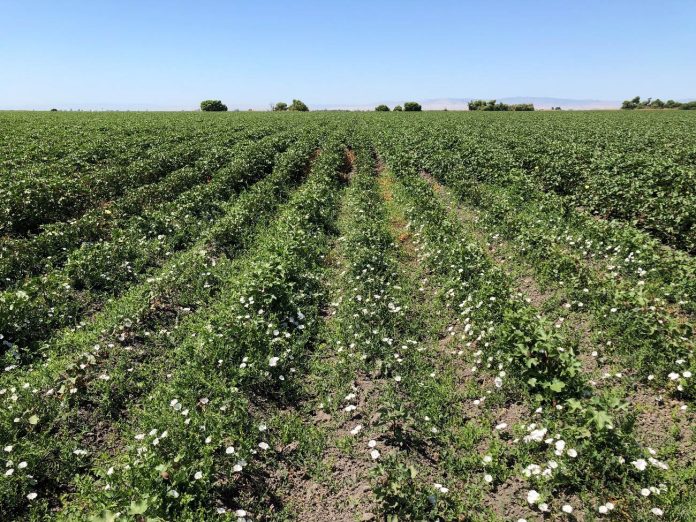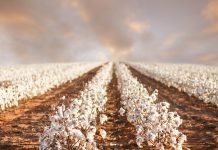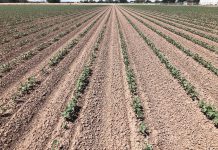Cotton is susceptible to weed interference, especially following emergence, as many weed species can outgrow and outcompete the newly germinated seedlings. This includes a weed native to California – Palmer amaranth (Amaranthus palmeri)- whose season-long germination phenology and high rate of photosynthesis enhances its ability as a crop competitor. Palmer amaranth interference significantly affects the growth and yield of most agronomic crops, with cotton being one of the more sensitive commodities. In addition to direct impacts on yield, Palmer amaranth can also interfere with harvest efficiency. Research has suggested that mechanical harvesting of cotton with Palmer amaranth at densities greater than six plants per 30 feet of row was impractical because of the potential for damage to equipment. Additional reports noted that the frequency of work stoppages increased as Palmer amaranth densities increased because of the need to repeatedly dislodge weed stems from the harvester.
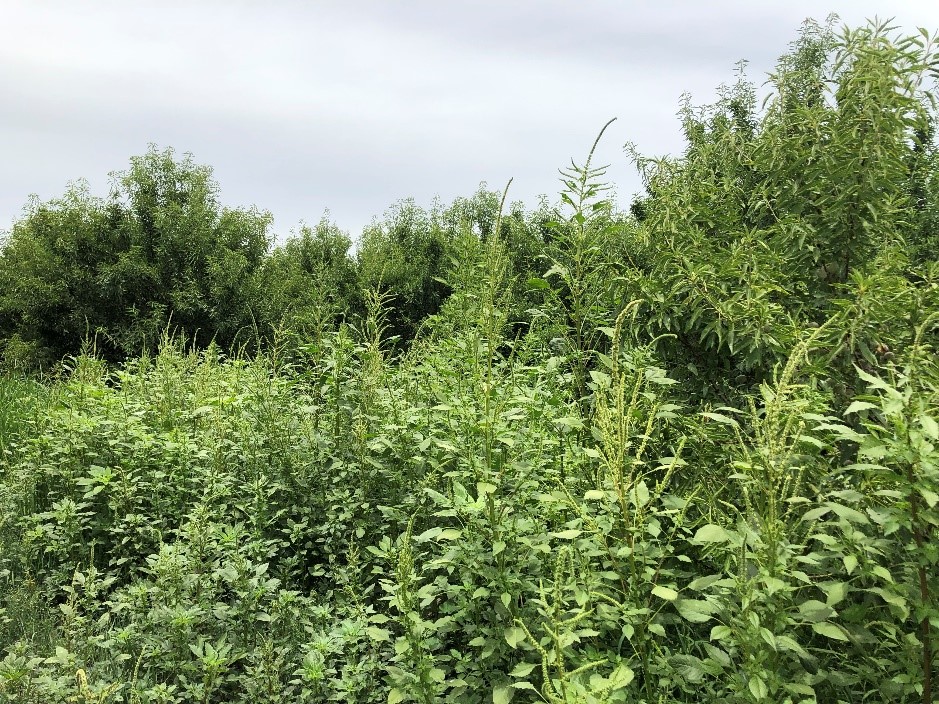
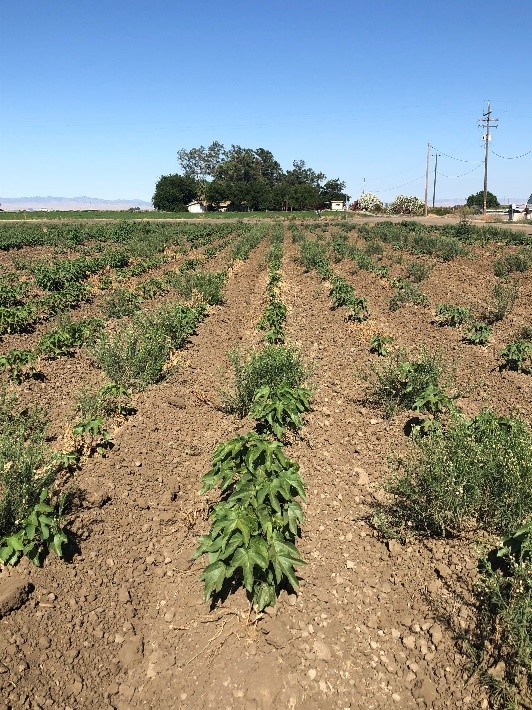
Currently, glyphosate is the predominant herbicide applied in California cotton for weed control. According to data derived from the California Department of Pesticide Regulation (CDPR) pesticide use reports, glyphosate was applied to 438,305 cotton acres in 2016, which is eight times more treated acreage than the next most commonly applied active ingredients (paraquat and oxyfluorfen). The use of glyphosate is not limited solely to cotton; glyphosate is an important component of weed control programs in a diverse array of crops, including almonds, alfalfa, corn, grapes, pistachios, and walnuts. The extensive use of glyphosate across commodities and over time has resulted in the selection for glyphosate-resistance in six species in California, including Palmer amaranth (Figures 1a and 1b, above).
Pesticide use reports indicate that California cotton growers do not regularly use residual herbicides on their planted acres; pendimethalin and flumioxazin were applied to less than half of California’s cotton acres in 2016, suggesting that growers are relying, heavily, on post-emergence measures (including glyphosate, hand-weeding, and cultivation) for weed control. Palmer amaranth has an exceptionally high growth rate, which allows the species to rapidly exceed height limits for chemical control. For example, glufosinate applications should be made to small (<3” in height) Palmer amaranth to prevent weed escape and regrowth.
In 2019, a trial was undertaken in Fresno, Calif., to describe the growth of Palmer amaranth in response to emergence date and to determine how quickly Palmer amaranth can overcome most herbicide label height limits. Palmer amaranth seed was collected in September of 2018 from a population growing alongside an agronomic crop field in Merced County. Seed were planted into 1.7-gallon pots containing all-purpose garden soil on April 21, April 28, May 30 and June 18, 2019. Palmer amaranth emerged on April 24th, May 2, June 2 and June 21 and were thinned to a density of one plant per pot (10 pots total per planting date). Palmer amaranth growth and development was recorded for each individual pot every second day until 20 days after emergence (DAE). Growing degree days (GDD) were calculated for each observation window using UC IPM models and Palmer growth regressed against GDD to predict critical stages (3 and 6 inches in height) for Palmer management.
All Palmer amaranth in this study reached a height of 3 inches by six to 10 DAE (Figure 2, below). Palmer emerging on April 24th and May 2nd reached a height of six inches 14 to 16 DAE, whereas Palmer amaranth emerging on June 2nd and June 24th reached a height of 6 inches 12 DAE. Plant heights at 20 DAE were 11.5, 8.5, 20.0 and 21.3 inches for the April 24th, May 2nd, June 2nd and June 21st emergence dates, respectively.
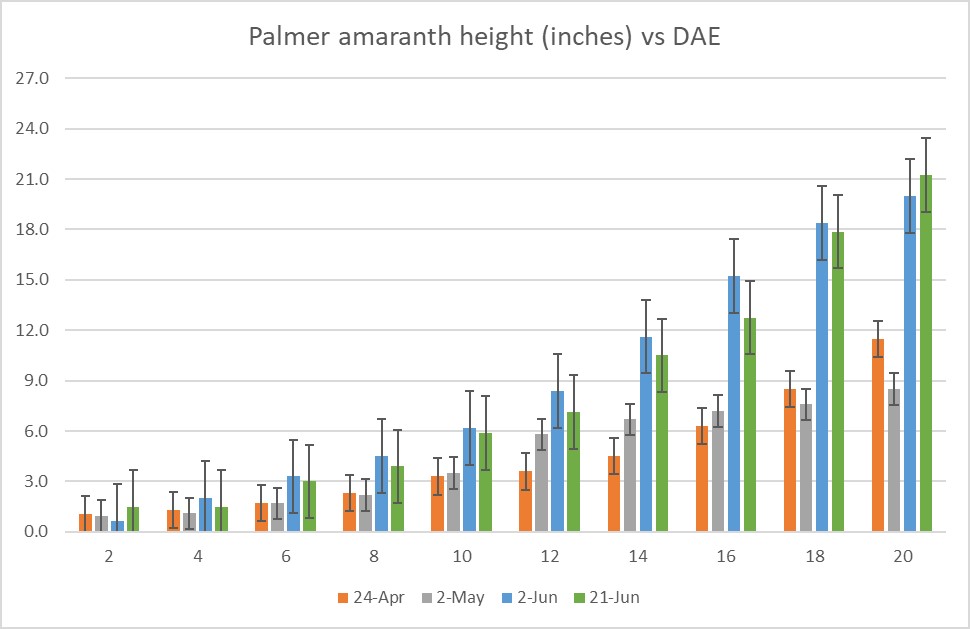
To standardize Palmer growth across all observation periods, plant heights were regressed against accumulated GDD using a second-order polynomial model; a threshold base temperature of 50 degrees F was used in the computation (Figure 3, below). Results indicated that the observed SJV Palmer amaranth population requires 175 to 180 GDD to achieve a height of 3 inches and 270 to 275 GDD to reach a height of 6 inches. This model can serve as a basis for predicting Palmer amaranth development in the future. Understanding the relationship between the accumulation heat units and plant growth makes it possible to predict when Palmer could become too large for control during a growing season regardless of yearly variation in temperature.
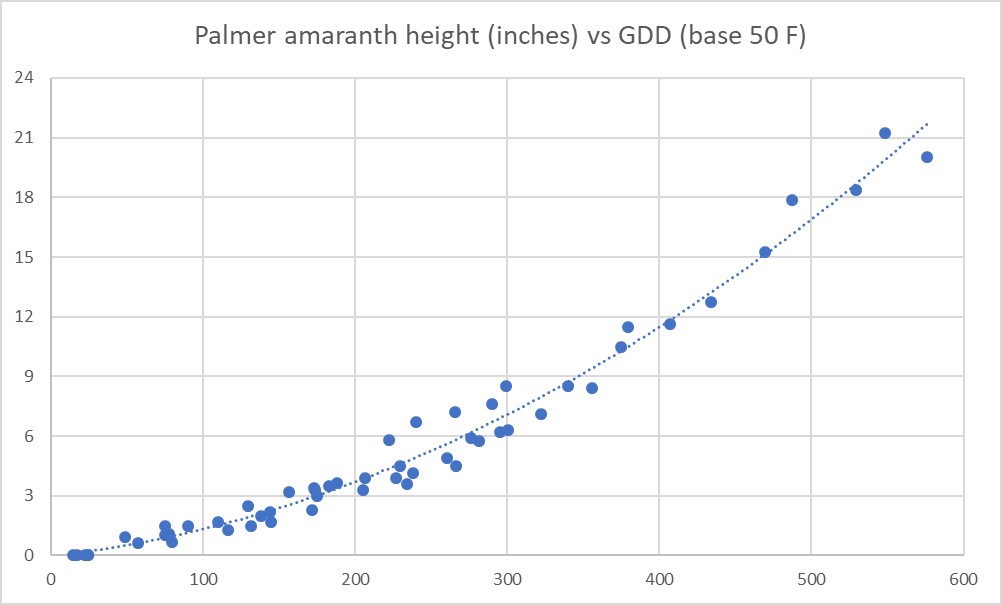
If Palmer amaranth escapes herbicide (or cultivation) treatments, hand-weeding may be needed to prevent Palmer amaranth from producing seed that can be returned to the soil seedbank. Remember: female Palmer amaranth can produce up to a million seed per plant, which can support an infestation for many years to come. When hand-weeding, plants should, ideally, be removed entirely from the field to prevent them from becoming re-established. Even plants that are cut off at or near the base of the stem can re-sprout and achieve reproductive maturity.
Escapes are not uncommon as Palmer amaranth can grow rapidly and outpace many control efforts. If plants become established in the field and hand-weeding is necessary, be sure to remove as much of the weed biomass as possible to prevent plants from growing and achieving reproductive maturity.
Field Bindweed Perennialization
Field bindweed (Convolvulus arvensis) is another species that has become problematic in California cotton, particularly in crop rotation systems that are characterized by drip irrigation and reduced tillage. In addition to negatively impacting cotton yield, bindweed can serve as an alternate host for the silverleaf whitefly, the honeydew from which is a primary source of sugars that can result in sticky cotton lint.
Field bindweed is a deep-rooted (up to 20 feet) and spreading perennial vine, Management guidelines often suggest that field bindweed is susceptible to control at the seedling stage, although there is limited information to suggest when newly emerged field bindweed vines assume the characteristics of perennial plants. Personal communications between weed scientists have indicated that field bindweed seedlings could survive defoliation attempts as soon as 3 WAE.
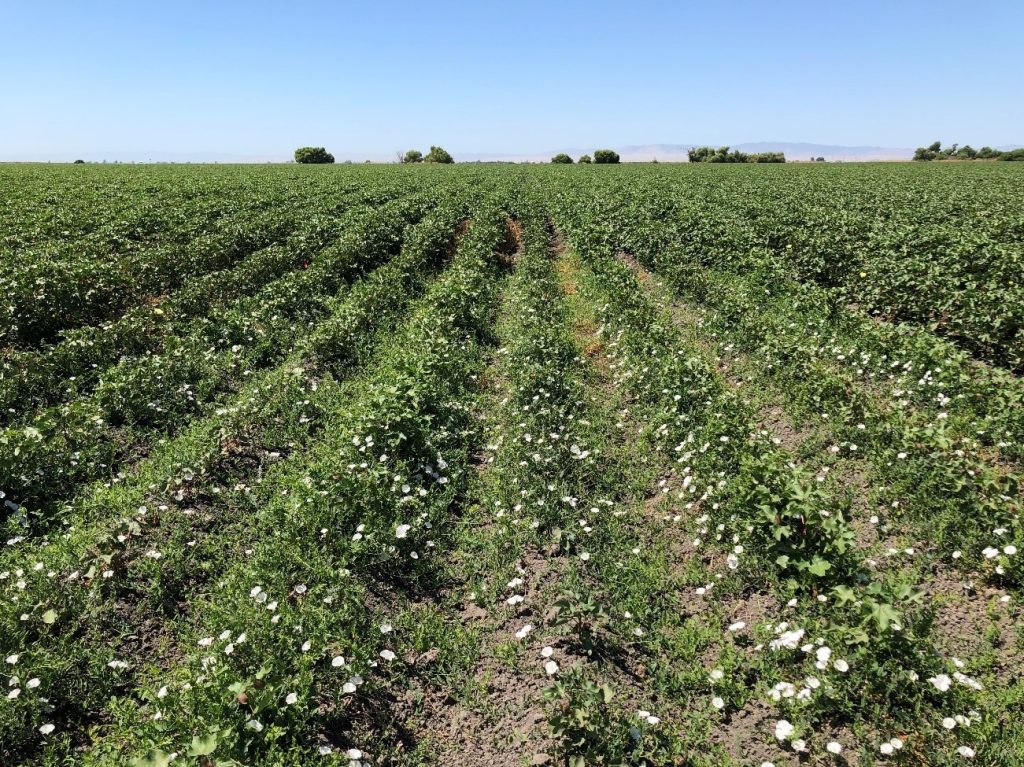
In 2019, a trial was undertaken in Fresno, Calif., to describe the growth of seedling field bindweed and to determine when the vines take on the characteristics of perennial plants; specifically, the study was designed to evaluate at what stage field bindweed can regrow from root buds following above-ground biomass removal. Field bindweed seed collected in Merced County in 2018 was scarified using boiling water to induce germination. Seed were planted into 1.7-gallon pots containing all-purpose garden soil on April 17 and June t, 2019, representing two runs of the trial. Bindweed emerged on April 20 and June 4, respectively. Four replicate bindweed seedlings were physically defoliated (by removing all aboveground biomass at the soil line) at either 2, 4, 6, or 8 WAE and their compensatory growth measured two weeks after the cutting treatment (WAT). A second set of seedlings were destructively harvested at 2, 4, 6, and 8 WAE to describe biomass accumulation at the time of cutting.
Results indicate that the ability of field bindweed to regrow following defoliation increased with plant age (Table 1, see below). Field bindweed seedlings defoliated at 2 WAE did not re-sprout by two weeks following cutting; no viable above- or below-ground tissue was observed and recorded. Thirty-eight percent of field bindweed seedlings defoliated at 4 and 6 WAE survived the cutting treatment and re-sprouted. One average, 0.5 to 3.0 grams of stem/leave and root tissue were recovered at 2 WAT. One hundred percent of the field bindweed defoliated at 8 WAE survived the cutting treatment and produced 13.1 and 35.9 grams of above- and below-ground tissue, respectively.
While most management practices are focused on controlling rhizomatous vines, the seed of field bindweed should not be ignored. Bindweed seed can remain viable in the soil for decades (Weaver and Riley 1982) suggesting that infestations can re-occur even if rhizomes are successfully eradicated from a site. Anecdotal evidence indicated that newly emerged seedlings could take on the characteristics of perennial vines, rapidly, following germination. Results from this study suggest that field bindweed seedlings may not remain sensitive to certain control measures for more than 4 weeks after emergence. Studies to examine seedling development and responses to contact and systemic herbicides will be conducted during the fall of 2019/winter of 2020.
Field Bindweed Response to Trifluralin and Pendimethalin
Results from previous studies in processing tomatoes have shown that trifluralin pre-plant incorporated (PPI) can suppress perennial field bindweed vines (Sosnoskie and Hanson 2015). However, most cotton growers do not regularly apply this active ingredient in their systems; with respect to pre-emergence herbicides, pendimethalin (which is in the same chemical family as trifluralin) is more commonly used.
Studies were initiated at the UC Westside Research and Extension Center in Five Points California in May 2019 to describe the response of field bindweed to trifluralin and pendimethalin relative to an untreated check. Trifluralin (24 oz/A Treflan) and pendimethalin (24 oz/A Prowl H2O) were applied on May 24 and physically incorporated to a depth of three inches. Individual plots were 13.5 feet in width and 50 feet in length. An untreated check (UTC) was also included. Bindweed pressure in the trial was considered to be significant; approximately half of the study site was covered in vines two weeks before the initiation of the trial. To ensure sufficient contact between the herbicide and the soil surface, the trial location was repeatedly disked to remove standing vegetation. Bindweed cover and flowering was assessed weekly from June 6 until July 16.
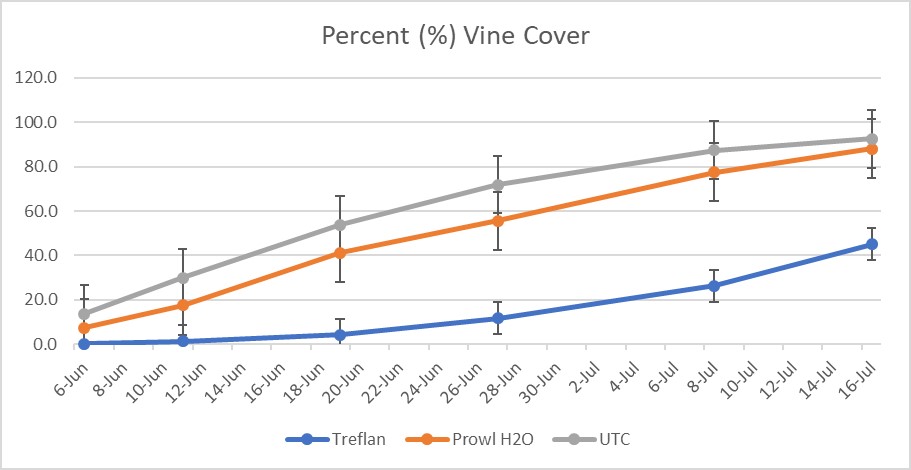
Few pre-emergence or pre-plant incorporated herbicides are registered for the suppression of perennial field bindweed vines. Trifluralin, a dinitroaniline microtuble inhibitor, has been shown to inhibit vine emergence while pendimethalin has not. Results from the 2019 trial demonstrated that vine cover in the trifluralin treatments was reduced by 50 percent or more relative to the untreated check and pendimethalin treatments (Figure 4, above). There were no differences between pendimethalin and the UTC. By July 16, mean bindweed cover in the trifluralin plots was 45 percent, whereas cover in the pendimethalin and UTC plots were 88 percent and 93 percent respectively. Flowering didn’t commence until June 27 in all treatments (<1% – trifluralin, 11% – pendimethalin, 27% – UTC) (Figure 5, below). Trifluralin also reduced flowering potential on July 8; however, by July 16, 90 percent of emerged vines were flowering in all treatments. Pendimethalin and trifluralin control a similar spectrum of weeds; if field bindweed is a concern in a field, growers may want to consider the use of trifluralin for vine suppression.
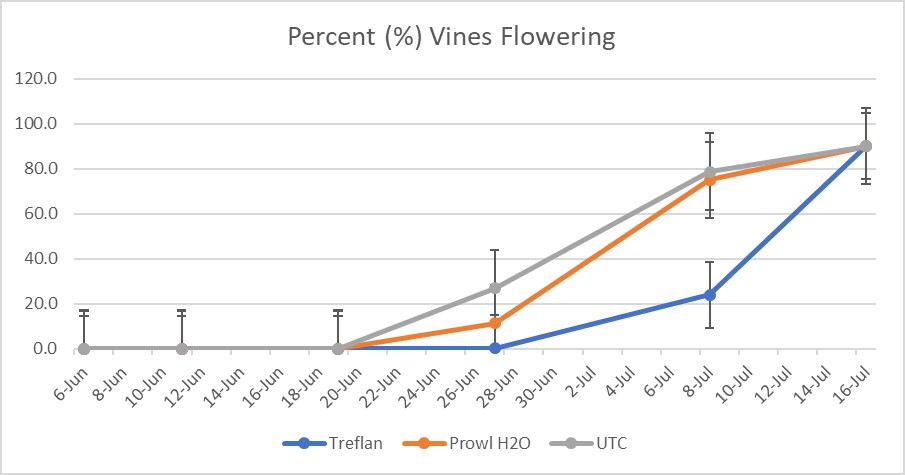
Continuing Research
A field trial to evaluate the combined effects of residual and postemergence herbicides and cultivation on vine control and cotton growth is ongoing and will be reported on at a later date. Results describing bindweed control in response to fall applied herbicides will also be presented later.






